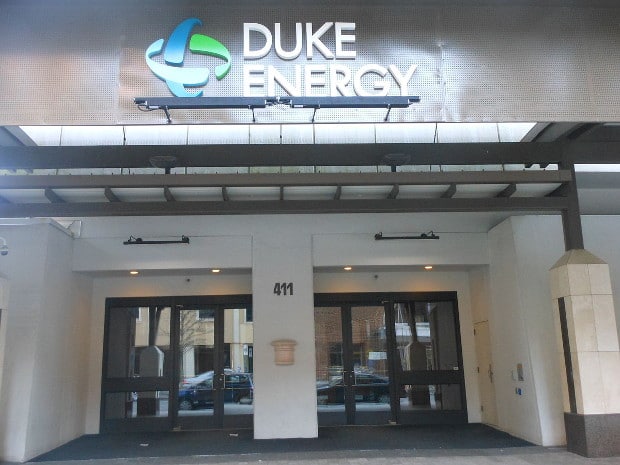We at pv magazine have written a number of articles about how Duke Energy, a power company from the conservative and slow-to-change U.S. South, has been a leader in the deployment of renewable energy.
However, it is important to note that as a power company that owns both power generation and utility arms, Duke is mostly deploying solar and other forms of renewable energy outside the places where it sells retail electricity to residential, business and industrial customers. And in many ways, the company still thinks like a 20th century utility.
Specifically, in its 2017 Climate Report to Shareholders, Duke shares with other utilities a denial of the increasing pace and potential of the transition to renewable energy, along with a preference for centralized conventional power sources, including nuclear generation.
Even in Duke’s “two-degree scenario analysis”, which rests on the assumption that zero-emitting load following technologies are commercially available, the company still only assumes that hydroelectric power, solar and wind will make up 23% of the generation in its service area, compared to 1% today.
Duke does not provide a 2050 forecast of the mix for its power generation business, but its 2030 figure shows a mere 10% wind, solar and hydro, which would imply a linear instead of exponential rate of growth, as its portion of wind, solar and hydro has already risen from a less than 1% in 2005 to 5% in 2017.
Wind and solar globally have seen exponential rates of growth during this time period, not linear. And in looking at future electricity mix for its utility business, BNEF Head of Solar Analysis Jenny Chase echoed pv magazine’s perspective in a comment on Twitter.
Also "hmmm", meaning "23% renewables by 2050 is really pretty unambitious even as a business-as-usual scenario". https://t.co/lLK98MfnSn
— Jenny Chase (@solar_chase) March 22, 2018
In fact, Duke’s projections for the supply of electricity to its utilities show a lower level of renewable energy consumption than the most recent 2050 projections by the U.S. Department of Energy’s Energy Information Administration, which have been sharply criticized for repeatedly underestimating the growth of renewable energy based on flawed assumptions.
Duke has its own set of oft-questionable assumptions baked in to its two degree scenario, such as that all of the existing nuclear reactors from which it sources power will be allowed by regulators to operate for more than 20 additional years, pushing plant lifespans as high as 80 years – well beyond the lifespan that any nuclear power plant has seen to date or that such plants were designed for.
Along with this is the strange forecast that nuclear generation will incrementally increase to 35% of its mix, along with rising demand. This could be the result of Duke making the bizarre assumption that it will build new nuclear power plants despite the economic disaster that conventional nuclear power has become, or an unfounded faith in new nuclear technologies becoming commercially available.
Another notable assumption is Duke’s expectation that the fall in renewable energy and energy storage prices will continue for another 10 years at a declining rate, and then increase with the cost of inflation. This point may be moot, as large-scale solar is already the cheapest form of generation in many parts of the nation.
But what may give away Duke’s odd pessimism about the growth of renewable energy is a section where it provides very low estimates about the amount of wind and solar that it can integrate into its mix – even with 13% “load following” zero carbon resources. In a passage reminiscent of debunked claims about maximum penetrations of wind and solar, Duke states:
As the adoption of renewables grows to between 20 and 30 percent of total generation, the value of the resource begins to diminish due to extended periods of excess energy in the spring and fall and insufficient output during the winter months. While energy storage helps to mitigate the periods of excess and lower output, storage alone cannot address the energy deficiency during the winter months.
Even if some of Duke’s questionable assumptions about geographical considerations were correct, assuming such a barrier ignores the ability of Duke to import power to meet demand. Ultimately, it is simply not in line with a host of studies that find that the United States could meet 80% or more of its power from wind and solar by 2050, including a 2012 study by the U.S. Department of Energy’s National Renewable Energy Laboratories and a more recent study led by Ken Caldeira.
But the missing factor regarding Duke’s pessimism about integrating renewable energy is that by its plans to keep inflexible nuclear generation online well beyond expected plant lifetimes, Duke will make renewable energy integration more difficult and expensive.
So while Duke may build some wind and solar – and even acquire solar developers – the company has chosen to keep itself attached to the technologies of the past, and to fight the future.
This content is protected by copyright and may not be reused. If you want to cooperate with us and would like to reuse some of our content, please contact: editors@pv-magazine.com.









Of course. Duke Energy spent millions of dollars lobbying last year. They figure as long as they can bribe the criminals in our government they don’t have worry about it. Those criminals won’t be there forever though and Duke Energy is going to run into a big problem.